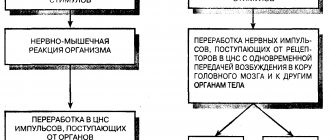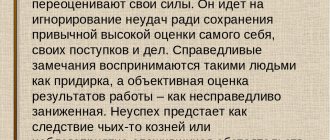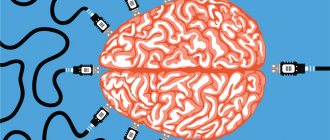In this article, psychologist Evgenia Dvoretskaya answers the question “How to recognize a man’s sympathy for a woman?”
People are accustomed to using speech to express their feelings. But not only with the help of linguistic means, you can tell your partner about your sympathy. Nonverbal signs are the emotions and gestures of our body, which we rarely manage to control. Psychologists say that correct interpretation of non-verbal signals is the key to effective communication and understanding of partners.
Nonverbal signs of confusion - VseOpsyhologii
To create a holistic picture of the communication process, it is important to take into account non-verbal ways of interaction between partners, since we receive two-thirds of the information about the interlocutor by observing his behavior. This is due to the fact that nonverbal communication includes more than seven hundred thousand facial and gestural movements of the hands and body, which is many times greater than the number of words in our native language. Moreover, the “richest alphabet” of non-speech “words” speaks of the true state of a person, because has a reflex nature [1; 4].
Albert Meyerabian found that the transfer of information occurs through verbal means by 7%, through intonation by 38%, and through facial expressions and gestures by 55%. Professor Birdswill, having conducted similar studies, also found that the average person speaks in words only for 10-11 minutes a day, and each sentence on average lasts no more than 2.5 seconds. Thus, verbal communication in a conversation takes up less than 35%, and more than 65% of information is transmitted using non-verbal means of communication. Consequently, a significant part of the “communication iceberg” lies under water, in the area of non-verbal communication [2; 3;].
Nonverbal communication is the exchange of nonverbal messages between people, as well as their interpretation.
Let's look at nonverbal signs or indicators of some common mental states and behavioral characteristics.
Uncertainty, nervousness, irritability
Characteristic signs are as follows: coughing (as if clearing the throat), frequent yawning, jingling keys or coins in the pocket, fidgeting in a chair, tapping your foot on the floor, tugging at your ear, and frequently looking away from your interlocutor.
Increased but hidden mental tension
It is clearly manifested in tightly clenched hands and clasped fingers (moreover, the greater the tension, the more tightly the hands are clenched, sometimes the fingers even turn white). Characterized by intense nervous rubbing of hands, fingers, pinching - in general, a variety of incessant small movements of the fingers. These also include manipulating a fountain pen, straightening paper clips, rotating them, etc.
In a state of high mental tension, people often look towards the door or window, as if involuntarily trying to get out of the room where they are experiencing discomfort. Therefore, their condition can be determined by the direction of their gaze. Characteristic under stress are so-called defensive movements that unconsciously help increase confidence. For men, this is stroking the neck, unbuttoning (or pulling) the collar of a shirt or tie. For women, a slow movement of the hand around the neck, as if touching a non-existent necklace. If it is put on at this moment, then touching it, as if checking whether it is in place, fingering it like a rosary. During a conversation, being in a state of strong mental tension, people may suddenly get up and walk around the room.
Aggression
Aggression is characterized by many very expressive gestures that occur in people in a state of high mental tension, but with their own specific specifics: a “pointing finger” aimed at an opponent (in psychology it is often called a “little sword”), a clenched fist, slamming a door, etc. .P. These are fairly simple, obvious signs.
Closedness
Closedness has very interesting nonverbal manifestations. When people do not want to make contact or seek to create a distance that prevents contact, they use a certain set of characteristic movements. The most common of them is the “lock pose” - arms crossed over the chest, fingers clenched into a fist, legs crossed. If such a person is sitting, then he leans back, increasing the distance between himself and his communication partner. Crossing your legs – “leg over leg” – also indicates the distance being created.
Trying to hide something
Characteristic postures and gestures when wanting to hide something are shown
vseopsyhologii.com
What are feelings for?
The functions of feelings in psychology are determined by their ability to leave information about significant events and objects.
- reflective - an assessment of what is happening in order to determine the degree of danger in order to find ways to prevent it;
- stimulating - feelings encourage you to look for ways to solve certain problems and determine goals for the future;
- reinforcing - thanks to feelings, a person remembers significant events, giving his own subjective assessment;
- switching - help set priorities, determine more important objects, actions, decisions. In other words, it is willpower;
- adaptive - based on previously experienced feelings, a person can more easily adapt to a new reality;
- communicative - the language of feelings is one of the effective ways to interact with others.
Confusion: causes, symptoms, diagnosis, treatment
There are two types of confusion: verbal and non-verbal. Both cannot be ignored: signs of confusion are difficult to hide. If it is verbal in nature, i.e. there is a failure in communication through speech, then contact between the interlocutors becomes difficult or completely absent. The one who is feeling confused will be confused, painfully searching for words, demonstrating a lack of complete or partial orientation in time. This condition can last from several hours to several days.
Nonverbal signs of confusion
Communication occurs not only through speech, but also with the participation of information provided by the human body. Facial expressions, gestures and gait will tell you whether there are non-verbal signs of confusion. The movements called “tactile” will be complemented: shaking hands, friendly pats on the shoulder or back, touching and other direct contacts.
A look will say a lot - its direction and duration. In addition, non-verbal signs are visible even in where exactly: how the person is positioned at the table, the distance, what exactly he is focusing on. Several previously unusual postures or movements, even without verbal contact, can indicate that a person is at a loss.
[26], [27], [28], [29], [30]
Panic and mental confusion
These terms do not require decoding: their meaning has been known for a long time. The key definition of “panic confusion” is the word “panic”. If we take the literal translation from the Greek “panikon” - “unaccountable horror”, it will become clear that we are talking about a psychological mood, or more precisely, a state that was provoked by external circumstances. They are filled with fear, which engulfs a huge number of people. This fear is dominated by the uncontrollability of a dangerous situation, the inability to manage it. A typical example is a flood or a volcano that suddenly “awakens”.
Mental confusion is inferior in scale to panic: it is inherent in a specific individual. But mental confusion can unsettle you for a long time and sometimes with tragic consequences. It can make a person helpless at the most crucial moment.
ilive.com.ua
Visual sign language of women
But women have a different visual body language. The weaker sex looks furtively. If a woman meets the eyes of a man she likes, she often looks like a thief who was caught in the act. She hides her gaze and blushes.
Among representatives of the fairer sex, it is considered correct to look at the object of sympathy in secret. But experienced ladies behave more confidently. They are also embarrassed, but after averting their eyes, they return their gaze again, accompanied by a smile.
Unlike representatives of the stronger sex, ladies examine a man they like from the bottom up. This direction has a double meaning. Initially, the girl gathers her courage before looking into the eyes. In addition, the meeting of views plays a serious role.
Nonverbal signs of sympathy and antipathy
| No. | Signs of sympathy | Signs of antipathy |
| 1 | Communication occurs in the personal zone of the spatial territory (from 45 cm to 1.2 m), gradually moving into the intimate zone (from 15 to 45 cm) | Communication takes place in the social zone (from 1.2 to 3.6 m) with a tendency to gradually increase the distance in this zone, |
| 2 | A handshake using both hands (the left hand clasps the wrist, elbow, forearm, shoulder). | No handshake or brief handshake with straight, tense hands. |
| 3 | Open hands, open palms to the interlocutor. | Fingers clasped. Arms crossed on the chest. |
| 4 | The hand on the elbow supports the cheek, but not the chin. | The thumb rubs or supports the chin, the index finger points upward to the temple. |
| 5 | One leg is slightly set back, the other is slightly in front, its toe points towards the interlocutor. | Crossing your legs over your legs, with your ankles pressed together. |
| 6 | Affirmative head nods. Tilt your head to one side. | Negative head shakes. Head tilt down |
| 7 | At When talking to a woman, the man’s thumbs are tucked into his belt or into the slits of his pockets. | A look from above: closed eyelids, head thrown back, long gaze. |
| 8 | The gaze of the interlocutors is met more than 2/3 of the time of the conversation. | The interlocutor looks his partner in the eyes less than 1/3 of the time and often looks away. |
| 9 | A sidelong glance with slightly raised eyebrows and a smile. | A sidelong glance with frowning eyebrows and downturned corners of the lips. |
| 10 | An intimate look - from head to toe (and vice versa). | Only a business look - not below the eye area. |
| 11 | Pupil dilation. | Looking over your glasses. |
| 12 | Preening (m): straighten your tie, hair, collar, cufflinks, belt, etc. Preening (g): straightening hair, part of clothing, using lipstick, etc. | Turning away from the interlocutor, taking the “starting position”, readiness to leave. |
| 13 | The legs are placed a little wider than usual. | Tapping, “trembling” of the foot. |
| 14 | For women: demonstration of the inside of the wrist, shoulder, knees, feet. | For men: hands with clenched fists on hips. |
| 15 | Copying your interlocutor's gestures. | When smoking, the smoke stream is directed downwards. |
| 16 | Turning the body towards the interlocutor, moving to the intimate area. | Deliberate reluctance to change position following the interlocutor. |
| No. | Signs of Confidence | Signs of anxiety |
| 1 | Intrusion into the intimate area of the interlocutor (from 45 to 15 cm). | The desire to conduct a conversation on the border of the personal zone (from 45 cm to 1.2 m). |
| 2 | Palm down gestures, pointing gestures. | Gestures with palm up with fingers apart. |
| 3 | When shaking hands, palm down, arm straight. The handshake is strong and energetic. The hand is dry and warm. | When shaking hands, palm up, arm bent. The handshake is limp and weak. The hand is wet, cold, |
| 4 | A handshake using both hands (the left hand clasps the wrist, elbow, forearm, shoulder). | No handshake or brief fingertip handshake. |
| 5 | Open fingers | Fingers clasped. |
| b | Spiral-shaped arrangement of palms and fingers. | Fingers in mouth. Nail biting. |
| 7 | Putting your hands behind your back: hand in hand. | Putting your hands behind your back: grabbing your wrist, elbow. |
| 8 | Emphasizing the thumbs: putting them behind a belt, lapels, in pockets. | Protecting your mouth with your hand, coughing. |
| 9 | Putting your hands behind your head. | Touching the nose, ear, pulling the collar. |
| 10 | Crossing arms over chest with thumbs up; fingers clenched into a fist. | Crossing your arms over your chest, palms under your armpits. |
| 11 | Hands on hips. | Adjusting cuffs, watch bracelets, turning buttons, pens, purses. |
| 12 | Crossing legs over legs with arms wrapped around legs, | Crossing your legs, pressing your ankles together, |
| 13 | Sitting astride a chair | Sitting on the edge of a chair. |
| 14 | 2/3 of the conversation time, the gaze is focused on the partner’s face. | Averting the eyes to the side, “running” eyes. |
| 15 | When smoking, the smoke is directed upward, blown out through the nostrils, head upward, | When smoking, the smoke is directed downward, the head downwards. |
| 16 | Super relaxed pose: legs on the table, arm of a chair. | The torso is tilted forward, the head and shoulders are lowered. |
| 17 | The desire to copy the gestures of the interlocutor. | Static posture or, conversely, fidgeting in place. |
| 18 | The desire to reduce the angle between the planes of bodies in a conversation. | The desire to increase the angle (turn away). |
studfile.net
Visual body language of men
To understand the visual body language of men and notice interest, it is important to note the direction of their gaze. Anyone who is interested in you looks you up and down. First, the man notices the general attractiveness, then lowers his eyes, lingers on the chest and hips, and after a while looks at them again.
If a certain representative of the stronger sex shows sympathy, this can be seen by the frequency of glances and the enlargement of the pupils.
NONVERBAL SIGNS. The psychology of political bluff
NONVERBAL SIGNS
Signs
Signs are signals whose meaning is completely clear. For example, a nod of the head. In some cases of deception, such signs are not completed and end abruptly.
Gestures
Gestures are primarily hand movements that are made to add credibility to words. People who tell lies often use gestures that seem out of place.
Involuntary skills
Such skills may be habits that are not noticed by the person himself, for example, touching the earlobe, stroking hair, squeezing and unclenching fingers, etc. During periods of stress, these skills become more noticeable.
Breath
Stress usually manifests itself in rapid breathing, which can often indicate intentional lying.
Coughing and frequent swallowing of saliva
Such manifestations of stress may indicate intentional lies.
Facial expression
Elusive or difficult to detect, quickly disappearing - in a split second - changes in facial expression often indicate hidden emotional arousal. With proper training, a person can always learn to catch them.
ATTENTION!
Detecting lies from politicians is not a science, but an art. None of the above signs can have independent significance; it is necessary to evaluate all the signs together. n
Share on the page
Next chapter >
psy.wikireading.ru
How to recognize a lie?
An interesting fact about how to recognize a lie: it turns out that sincerity or vice versa, a lie in relation to disposition towards you arises depending on the speed and simultaneity of widening the eyes and raising the corners of the mouth. For example, if you notice that the interlocutor’s eyes are slowly opening, while he rarely blinks and smiles, it means that there is a threat towards you. Or vice versa, if he allows himself to close his eyes for a short time, he trusts you and is disposed to sincere interaction.
There are also the following signs:
- Hesitation in conversation or long pauses.
- The facial expressions seemed to freeze for about 10 seconds - a clear sign of falsehood and a feigned demonstration of feelings.
- A pause between spoken words and emotional manifestations.
- Avoiding prolonged eye contact, the gaze is mostly restless.
- Few gestures or gesticulation only with the right hand, and sometimes vice versa, excessive movements and inappropriate feelings.
- Breathing is heavy, facial expressions are weak, blinking is rapid.
Nonverbal signs of communication
The article examines the signs of nonverbal communication, which are characteristic of absolutely any person, regardless of race, status, etc. Knowing these signs will allow you to better understand your partner's emotions and correctly interpret the situation.
To create a holistic picture of the communication process, it is important to take into account non-verbal ways of interaction between partners, since we receive two-thirds of the information about the interlocutor by observing his behavior. This is due to the fact that nonverbal communication includes more than seven hundred thousand facial and gestural movements of the hands and body, which is many times greater than the number of words in our native language. Moreover, the “richest alphabet” of non-speech “words” speaks of the true state of a person, because has a reflex nature [1; 4].
Albert Meyerabian found that the transfer of information occurs through verbal means by 7%, through intonation by 38%, and through facial expressions and gestures by 55%. Professor Birdswill, having conducted similar studies, also found that the average person speaks in words only for 10-11 minutes a day, and each sentence on average lasts no more than 2.5 seconds. Thus, verbal communication in a conversation takes up less than 35%, and more than 65% of information is transmitted using non-verbal means of communication. Consequently, a significant part of the “communication iceberg” lies under water, in the area of non-verbal communication [2; 3;].
Nonverbal communication is the exchange of nonverbal messages between people, as well as their interpretation.
Let's look at nonverbal signs or indicators of some common mental states and behavioral characteristics.
Uncertainty, nervousness, irritability
Characteristic signs are as follows: coughing (as if clearing the throat), frequent yawning, jingling keys or coins in the pocket, fidgeting in a chair, tapping your foot on the floor, tugging at your ear, and frequently looking away from your interlocutor.
Increased but hidden mental tension
It is clearly manifested in tightly clenched hands and clasped fingers (moreover, the greater the tension, the more tightly the hands are clenched, sometimes the fingers even turn white). Characterized by intense nervous rubbing of hands, fingers, pinching - in general, a variety of incessant small movements of the fingers. These also include manipulating a fountain pen, straightening paper clips, rotating them, etc.
In a state of high mental tension, people often look towards the door or window, as if involuntarily trying to get out of the room where they are experiencing discomfort. Therefore, their condition can be determined by the direction of their gaze. Characteristic under stress are so-called defensive movements that unconsciously help increase confidence. For men, this is stroking the neck, unbuttoning (or pulling) the collar of a shirt or tie. For women, a slow movement of the hand around the neck, as if touching a non-existent necklace. If it is put on at this moment, then touching it, as if checking whether it is in place, fingering it like a rosary. During a conversation, being in a state of strong mental tension, people may suddenly get up and walk around the room.
Aggression
Aggression is characterized by many very expressive gestures that occur in people in a state of high mental tension, but with their own specific specifics: a “pointing finger” aimed at an opponent (in psychology it is often called a “little sword”), a clenched fist, slamming a door, etc. .P. These are fairly simple, obvious signs.
Closedness
Closedness has very interesting nonverbal manifestations. When people do not want to make contact or seek to create a distance that prevents contact, they use a certain set of characteristic movements. The most common of them is the “lock pose” - arms crossed over the chest, fingers clenched into a fist, legs crossed. If such a person is sitting, then he leans back, increasing the distance between himself and his communication partner. Crossing your legs – “leg over leg” – also indicates the distance being created.
Trying to hide something
Characteristic postures and gestures when wanting to hide something are manifested in an original and well-interpreted manner - often this is mechanically covering the mouth with one hand or two hands. This is also evidenced by rubbing your temples and chin with your fingers, looking away to the side, and tilting your body away from your interlocutor.
Confidence
In this case, I would like to talk not about confidence itself, but about demonstrative behavior that helps to gain it. This usually manifests itself in a raised and forward chin, good posture and clasping hands behind the back, when a person slowly and confidently walks back and forth, preparing for a difficult conversation in which one must not “lose face.” Another very characteristic movement is connecting the fingers of both hands with a “dome”, while the palms do not touch. This gesture is also interesting because it indicates a desire for constructive dialogue, but not simple, but with a desire to dominate. It is noted that the higher the rank or status of the speaker, the more confident he is in his position or correctness, the higher he raises this kind of “dome”, up to eye level, but not higher.
Willingness for dialogue and interaction
Here are some postures and gestures that indicate such intentions: sitting on the edge of a chair, leaning the body forward towards the interlocutor, an unbuttoned jacket, gesticulation of the face, an attentive look, friendly intonations. If at the same time openness is demonstrated, then the arms are slightly extended forward and to the sides, the palms are open, and the arms are often made in circular movements.
Self-control
Self-control in men manifests itself most clearly when they are sitting in a chair: their legs are slightly extended, their ankles are crossed, and most importantly, their hands are squeezing the armrests. If a person speaks from the podium, then the hands are directed forward and firmly hold its side edges. It is also a gesture of confidence. Gestures of self-control in women are unique; the following is often seen: the thumb is hidden behind the waistband of a skirt or belt [5; 6; 7].
novainfo.ru
Searching for truth in a glance
To figure out whether a person sympathizes with you or not, you need to carefully look for the truth in his gaze. A person's eyes will be clear if he truly likes you.
There are hidden and overt forms of showing interest. If a person openly demonstrates sympathy, then respect is noticeable in his gaze. The eyes are open wide, and the stronger the sympathy, the more the pupils dilate.
People use hidden expressions of sympathy if they are afraid of disappointment or deception. But, despite the fear, he is trying to somehow contact you, observe or watch. The hidden sympathetic gaze is different: a person looks at a person he is interested in furtively, so as not to be noticed. If eyes meet, he immediately looks away. But from the outside, such behavior is very noticeable.
The views of the different sexes are quite different. Women are more resourceful. They are the ones who know how to “shoot” with their eyes and play “staring contest”.
Nonverbal manifestation of a person's emotional states
Hello dear readers of my blog! Communication is a very important process in the life of every person, thanks to it our psyche develops, we advance, socialize and generally live. And today I want to invite you to consider one of its types, namely the nonverbal manifestation of a person’s emotional states. After all, it makes up from 60 to 95% of the information that we unconsciously present to others.
What it is?
In simple terms, nonverbal communication is communication without the help of words. And not only between people, but also when interacting with animals. It also helps to understand the interlocutor more deeply and express more complex feelings for which it is impossible to find words, or if a person does not realize what is happening to him, then the body gives him and those around him a hint about his condition. You might think, why do we need to know more, because verbally it’s so simple, right?
But words can deceive, and some movements and processes in the body, depending on the experience of any feeling, cannot be faked. For example, even if you adopt the posture and appearance of a frightened person, your pupils will not dilate and your palms will not sweat from fear. You can learn more about such nuances in the following article: “The most interesting features of nonverbal communication between people,” but now I suggest you familiarize yourself with the main types:
Kinds
1.Voice
In fact, it is not only a means of communication, but also a very complex tool for a person, with the help of which he can shout, laugh, cry and, with a change in intonation or tone, makes others understand about his position and condition. For example, by the usual word: “Hello,” you can determine whether they are glad to meet you, greeted you formally, are completely unfriendly towards you, and so on.
Voice Characteristics
- Speed of speech: a fast pace indicates impulsiveness and confidence, a slow pace indicates poise and restraint. But if there are fluctuations, speech either speeds up or slows down, this signals uncertainty and the inability to control oneself due to emotions and slight excitability.
- Loudness: a loud voice belongs to a person with an active lifestyle and a lot of vital energy. A quiet voice means modesty, restraint in expressions, but jumps indicate excitement and feelings at the time of conversation.
- Articulation: Clear pronunciation indicates a desire to be understood, and incomprehensible pronunciation indicates a lack of confidence in oneself and one’s point of view.
- Height: falsetto belongs to a person with a high level of intelligence, a voice from the chest - sincere and emotional, too high, squeaky - means fear, low timbre - self-confidence, relaxation and the ability to influence others, evoke respect and admiration.
Characteristics of laughter
- Ha-ha-ha – carefree, open and cheerful.
- He-he-he - wayward, stubborn.
- Hi-hi-hi – sarcastic, malicious.
- Ho-ho-ho - boastful, rebellious.
- Hu-hu-hu - cowardice, sometimes unconscious fear.
2. Facial expressions
Facial expressions are facial expressions that reflect the various feelings that a person experiences. They are only expressed slightly differently on each side of the face, due to the fact that the left hemisphere of the brain is responsible for the intellectual sphere, and the right for the emotional.
Characteristics of the gaze
- Wide open eyes mean liveliness and readiness to perceive information from the outside, but too open eyes indicate increased attachment to the world.
- Squinted or intensely narrowed eyes - concentration, cunning, watching someone and signs of increased attention.
- Direct means interest and willingness to communicate.
- If they only look at you from the corners of their eyes, then know that they do not trust you and are skeptical about what you say.
- From top to bottom – excessive self-confidence, even to the point of arrogance.
- Avoiding your gaze is modesty, or living a feeling.
Characteristics of a smile
- The corners of the mouth pulled down indicate a person’s pessimism.
- Conversely, those raised up symbolize a cheerful and optimistic personality.
- A plump and soft mouth is a sign of sensitivity and increased vitality.
- Sharp, thin lips indicate intelligence and willpower.
Let's now look at how a person's feelings manifest themselves in order to better understand the behavior of the interlocutor and the thoughts and sensations he experiences, because what he says is not always true.
Showing feelings
- Anger, anger - the eyes open wide, the teeth clenched, and the gaze becomes narrowed.
- Surprise - again, the eyes open wide, only in case of surprise the eyebrows also rise and the mouth opens slightly.
- Fear - a frightened person draws his eyebrows together, his lips stretch slightly, the corners of which move downwards.
- Happiness, joy - raised corners of the lips, and a calm and open look.
- Sadness - the look seems to be extinguished, completely without interest in others, the eyebrows are drawn together, and the corners of the lips are lowered down.
- Admiration - long eye contact, with a calm gaze.
- Indignation – prolonged eye contact, without pauses, intent and slightly anxious.
- Interest in another - an attentive gaze with pauses, approximately every 10 seconds.
- Hostility manifests itself when the interlocutor looks away, not wanting to make eye contact.
3.Gestures and postures
If you are attentive to the behavior of another person, you will observe what position of the hands, body, what gestures he uses when interacting with you - you will be able to recognize true intentions and notice whether he is lying or really speaking sincerely.
Characteristic
- Crossing your arms over your chest means expecting something or is used as a defensive reaction. If hidden behind his back, he is not going to act or do anything now, open palms are a sign that the person is sincere at the moment, but if he hides them in his pocket, he symbolizes the desire to hide something, a feeling of uncertainty and static.
- If you notice that the interlocutor is clenching his hand into a fist, do not be alarmed; this is not always a symbol of aggression, but only a desire to master the feeling of internal anxiety and concentrate. But if the tip of the index finger and thumb touch, while the little finger protrudes, it is a symbol of very strong concentration on any details.
- If at least one hand rests on the hip, this means that the person is trying to demonstrate his superiority due to a feeling of uncertainty and embarrassment, that is, falling into a completely different polarity.
- When the hands lean on a chair, table, etc., trying to support the body in this way, this means that it is important for him to feel that there is a feeling of safety and support, then he will feel strength again.
Types of gestures
- Openness - shrugging shoulders, showing open palms and arms in general, unbuttoning shirts and other things. A person who is ready for a sincere conversation sits on the very edge of the chair to be closer to the interlocutor. When both are in a friendly mood, they will repeat each other’s movements and poses.
- Defense - arms crossed on the chest or clenched into a fist; communication in this case is unlikely to lead to a compromise.
- Evaluation, reflection - a hand resting on the cheek means that the interlocutor is in deep thought, but if the chin is supported by the palm, with the index finger extended along the oval of the face - they are critically evaluating you, not trusting you, being in the position of “we’ll see.” If your head is tilted, they are listening to you and getting involved in the process as much as possible. Reflection and the moment of choice, decision-making - when you notice that the other is scratching his chin, pacing back and forth, pinching the bridge of his nose, and if he has glasses, doing some kind of manipulation with them.
- Boredom and lack of interest - a blank look, mechanically drawing something, tapping with a foot or hand.
- Flirting - Women usually preen themselves, straightening their hair, slowly crossing their legs, stroking their thighs or calves. The behavior of men is slightly different, they straighten their tie, jacket, raise and lower their chin, straighten...
- Hiddenness, suspicion - the hand usually covers the mouth, the legs and body are turned towards the exit, rubbing the eyes, ear, nose, as well as looking away to the side.
- Gullibility - fingers connected in the form of a dome
- Self-control - hands are placed behind the lower back and hidden, or, if a person is sitting, but at the same time crosses his legs and grabs the armrests with his hands. If you notice that you are twitching your ear, this means that you have a great desire to stop talking, but you control yourself and do not allow this to happen.
- Anger and frustration - rapid breathing, tense and tightly intertwined hands, sometimes clasped, squeezing one another.
Gait characteristics
- Long steps most often characterize a purposeful, assertive and active person.
- A rhythmic gait is characteristic of those walking in a good mood.
- A clear, military-like step is a sign of strong will and determination.
- Shuffling – laziness, lack of goals and aspirations.
- Firm, tense, as if on stilts - tightness, embarrassment and lack of communication.
Characteristics of posture during sleep
- On his side, curled up, pressing something to his stomach - such a person wants help, he needs support and protection. Their body language indicates an unwillingness to take responsibility for their lives; they are sensitive and impulsive, mainly guided by desire rather than common sense.
- On your side, curled up, with your arms and legs spread out, there is balance and the ability to adapt to changes.
- On their stomachs, with their arms outstretched, they are predictable, calculating and love it when power is in their hands.
- Sociable and self-confident people sleep on their backs, with their hands under their heads; they are optimistic and loyal.
- On their sides, with their knees bent - usually balanced people who are capable of compromise and do not tolerate conflict situations rest. They are not brave enough and like to be invisible.
- With their foot off the bed, they live at a very fast pace and do not know how to pause to notice the surrounding reality.
- Wrapped completely in a blanket - shy and cowardly.
- Legs placed one on top of the other indicate that a person cannot realize something in himself or understand the events that happen to him.
- On his stomach, with his hands under him - punctual, prudent, does not like surprises, trying to predict events and their results in advance.
How to recognize a lie?
An interesting fact about how to recognize a lie: it turns out that sincerity or vice versa, a lie in relation to disposition towards you arises depending on the speed and simultaneity of widening the eyes and raising the corners of the mouth. For example, if you notice that the interlocutor’s eyes are slowly opening, while he rarely blinks and smiles, it means that there is a threat towards you. Or vice versa, if he allows himself to close his eyes for a short time, he trusts you and is disposed to sincere interaction.
There are also the following signs:
- Hesitation in conversation or long pauses.
- The facial expressions seemed to freeze for about 10 seconds - a clear sign of falsehood and a feigned demonstration of feelings.
- A pause between spoken words and emotional manifestations.
- Avoiding prolonged eye contact, the gaze is mostly restless.
- Few gestures or gesticulation only with the right hand, and sometimes vice versa, excessive movements and inappropriate feelings.
- Breathing is heavy, facial expressions are weak, blinking is rapid.
Conclusion
These are the main types of manifestations of nonverbal communication, if you want to know more, you can look at my article “TOP 10 best books about nonverbal communication that are worth reading,” where I indicated a list of literature that is easy to understand and at the same time informative.
That's all, dear friends, do not forget to subscribe to blog updates. See you soon.
qvilon.ru
What it is?
In simple terms, nonverbal communication is communication without the help of words. And not only between people, but also when interacting with animals. It also helps to understand the interlocutor more deeply and express more complex feelings for which it is impossible to find words, or if a person does not realize what is happening to him, then the body gives him and those around him a hint about his condition. You might think, why do we need to know more, because verbally it’s so simple, right?
But words can deceive, and some movements and processes in the body, depending on the experience of any feeling, cannot be faked. For example, even if you adopt the posture and appearance of a frightened person, your pupils will not dilate and your palms will not sweat from fear. You can learn more about such nuances in the following article: “The most interesting features of nonverbal communication between people,” but now I suggest you familiarize yourself with the main types:
Body language of a man who is interested in a girl
At the subconscious level, the body language of a man who likes you is expressed like this. First, he tries to attract the attention of the girl he likes by simply preening himself. This is an instinct from nature: the guy will begin to straighten his hair, straighten his tie, collar, jacket. These are movements at the subconscious level, even when a person hides feelings.
Representatives of the stronger sex often hide their thumbs behind their belts. Even if a man is just standing, and his body is turned towards a pretty lady, then the toe of his foot is certainly directed in her direction. Often when talking to pretty women, they put their hands in their pockets, leaving their thumbs outside. This is obvious evidence that he is interested in your person, and he is trying to make a good impression.











